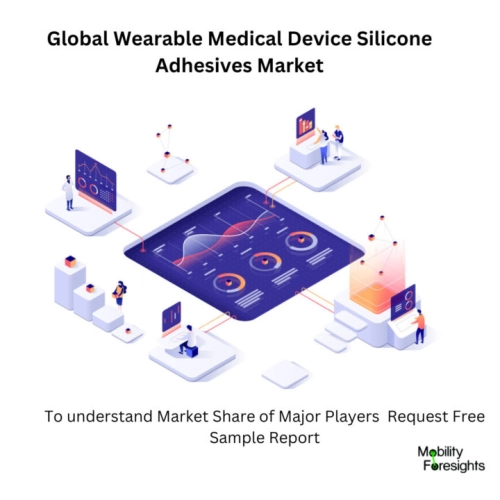
- Get in Touch with Us

Last Updated: Apr 25, 2025 | Study Period: 2024-2030
Wearable medical device silicone adhesives are a type of adhesive material that can bond wearable medical devices to the skin of patients or users. Wearable medical devices are devices that can monitor, diagnose, treat, or prevent various health conditions by being attached to the body.
Examples of wearable medical devices are glucose monitors, insulin pumps, cardiac monitors, electrocardiogram (ECG) patches, and drug delivery patches.
Silicone adhesives offer many advantages that make them uniquely suitable for wearable devices. Medical-grade silicones are biocompatible and have delivered proven performance in medical device applications for 70 years. They are non-cytotoxic, non-irritating and non-sensitizing to skin.
Silicone is hydrophobic, so a device using silicone could potentially be worn in the shower. Silicone adhesives also have excellent thermal stability, flexibility, conformability, and breathability, which can enhance the comfort and compliance of the wearer.
Some of the challenges that wearable medical device silicone adhesives need to address are:

The Global wearable medical device silicone adhesives market accounted for $XX Billion in 2023 and is anticipated to reach $XX Billion by 2030, registering a CAGR of XX% from 2024 to 2030.
2480 3M⢠Hi-Tack Silicone Adhesive is a type of silicone adhesive that is designed for wearable medical devices that need longer and stronger wear time. It is a single-coated medical nonwoven tape that consists of a white spunlace polyester nonwoven backing, one side coated with 3M proprietary silicone adhesive for repositionable attachment to skin. It has the following features:
High initial tack that enables secure attachment with minimal pressure
Gentle removal that minimizes skin trauma and discomfort
Suitable for people with fragile or sensitive skin
Compatible with ethylene oxide sterilization
High shear strength, low peel strength, low modulus, and high elongation properties
Flexible and conformable to accommodate various device shapes and sizes
Resistant to moisture, sweat, body oils, and environmental factors
Low coefficient of friction that reduces skin shear forces during wear and removal
Low volatile organic compound (VOC) emissions
Dow, which develops DOWSIL⢠MG 7-1010 Soft Skin Adhesive that is a soft silicone gel with high tack and low peel strength. It is suitable for long-term wear applications such as continuous glucose monitoring (CGM) devices. It has a low coefficient of friction that reduces skin shear forces during wear and removal.
Elkem Silicones, which offers a range of silicone materials for wearable solutions, such as electronic silicone adhesives (ESAs), textile coating systems (TCS), and medical grade silicones.
DuPont Liveo, which provides healthcare silicone solutions for skin contact applications, such as pressure sensitive adhesives (PSAs) and soft skin adhesives (SSAs) for wearable monitoring devices and wound care products.
DuPont, which offers Liveo⢠silicone skin adhesives that are pressure-sensitive adhesives (PSAs) and soft skin adhesives (SSAs) for various wearable device applications. Liveo⢠silicone skin adhesives have high shear strength, low peel strength, low modulus, and high elongation properties.
3M Medical Materials and Technologies, which offers a wide spectrum of silicone adhesives and films for medical devices, including wearables, with features such as sterilizability, chemical compatibility, biocompatibility, durability, and hydrolytic stability.
3M, which provides 2480 3M⢠Hi-Tack Silicone Adhesive that is designed for people with fragile skin. It has a high initial tack that enables secure attachment with minimal pressure. It also has a gentle removal that minimizes skin trauma and discomfort.
Henkel, which provides a portfolio of silicone adhesives for wearable devices, such as LOCTITE® SI 5970â¢, a one-part RTV silicone sealant that offers high flexibility and adhesion to various substrates.
| Sl no | Topic |
| 1 | Market Segmentation |
| 2 | Scope of the report |
| 3 | Abbreviations |
| 4 | Research Methodology |
| 5 | Executive Summary |
| 6 | Introduction |
| 7 | Insights from Industry stakeholders |
| 8 | Cost breakdown of Product by sub-components and average profit margin |
| 9 | Disruptive innovation in the Industry |
| 10 | Technology trends in the Industry |
| 11 | Consumer trends in the industry |
| 12 | Recent Production Milestones |
| 13 | Component Manufacturing in US, EU and China |
| 14 | COVID-19 impact on overall market |
| 15 | COVID-19 impact on Production of components |
| 16 | COVID-19 impact on Point of sale |
| 17 | Market Segmentation, Dynamics and Forecast by Geography, 2024-2030 |
| 18 | Market Segmentation, Dynamics and Forecast by Product Type, 2024-2030 |
| 19 | Market Segmentation, Dynamics and Forecast by Application, 2024-2030 |
| 20 | Market Segmentation, Dynamics and Forecast by End use, 2024-2030 |
| 21 | Product installation rate by OEM, 2023 |
| 22 | Incline/Decline in Average B-2-B selling price in past 5 years |
| 23 | Competition from substitute products |
| 24 | Gross margin and average profitability of suppliers |
| 25 | New product development in past 12 months |
| 26 | M&A in past 12 months |
| 27 | Growth strategy of leading players |
| 28 | Market share of vendors, 2023 |
| 29 | Company Profiles |
| 30 | Unmet needs and opportunity for new suppliers |
| 31 | Conclusion |
| 32 | Appendix |